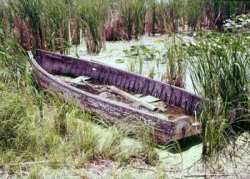 |
 |
| Home | Welcome | What's New | Site Map | Glossary | Weather Doctor Amazon Store | Book Store | Accolades | Email Us |
 | |||||||||
Weather Almanac for May 2001ANOTHER FINE VINTAGE
Growing up and living most of my life in the Great Lakes region, I found the contrasts between the various air masses passing through the region were as different as red and white wines: stifling hot and humid maritime tropical air one day, then after much flash and bang, chillingly cold, dry polar continental air the next. Meteorologists, particularly those involved with weather forecasting, understand that differences in the properties of air masses reveal clues about the weather to come. Formal characterization of air masses emerged about a century ago from the famed Bergen School of Norwegian meteorologists, particularly Tor Bergeron. But, it is likely that humans first recognized differences in air masses in prehistoric times when they realized that changes in weather conditions had recognizable, repeatable patterns and sensual properties: hot or cold, damp or dry. Until the 17th Century, early weather observers, like the wine taster, relied on their senses to distinguish differences between air masses. With the advent of instrumentation to measure atmospheric properties, particularly, pressure, temperature and humidity, it was now possible to formally describe the variability among air masses (which Bergeron did). Once networks of simultaneous weather observations became established, air masses were revealed to be very large volumes of air with similar temperature and moisture characteristics.
A number of such breeding grounds ring the globe, tucked away from strong global wind belts so that the nascent air mass can mature. The poles and the equator offer special incubators: the former producing frigid, dry air masses -- arctic or antarctic; the latter, very hot and humid air masses -- equatorial. Eventually, all air masses are pushed from their nest by global wind currents forcing them mingle with other traveling air masses. Cold air masses generally seek warmer latitudes while warm ones prefer northward journeys. As with all travelers, air masses are altered by their sojourns. Many clash violently with those of opposite origin, producing severe thunderstorms or blizzards or strong winds along their boundaries. At times, large spirals, that we know as cyclonic weather systems, spin off along the boundary zone or front. Finally, old air masses, travel-worn and battle-scarred and now with little commonality to their birthplaces, settle into some quiet corner of the globe. Here, they undergo a transformation, slowly assuming the properties of their hideaway. If they remain long enough, they are transformed to a metamorphosed air mass, ready to begin new travels. At any given moment, about fifty distinct air masses spread across the globe. As I write this, I am under one of polar maritime origin. You, the reader, will be under another, or perhaps caught in the transition zone between two air masses. Here on the northern Pacific coast of North America, air mass changes are generally more subtle that what I experienced in the Great Lakes region. The parallel mountain ranges of the western regions keep most continental air masses from reaching us. Because we are near a breeding ground for polar maritime air masses, our experience is more like watching an endless freight train roll by: box cars of minor variations, the pattern broken by the occasional tanker or hopper car -- but never a caboose. I do miss the wide variety of air mass influences of my former home, but my air-mass palate has become more finely tuned living here on the coast. As I step out onto the balcony this morning, I breathe deeply: "Ahhhhhh! Superb! A fine vintage indeed. For more on Air Masses and their characteristics, see the article Air Masses: A Base for Weather Analysis on this website. Learn More From These Relevant Books
|
|||||||||
 |
To Purchase Notecard, |
Now Available! Order Today! | |
 |
 |
NEW! Now |
The BC Weather Book: |


